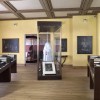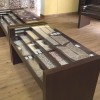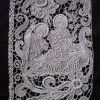In the 17th century, the century of lace par excellence, which invaded the male, female, junior, ecclesiastical and professional apparel from head to toe, Flanders, Milan and Genoa specialised in bobbin work, while Venice, although not excluding it, created inimitable needle-work artefacts. Baroque lagoon laces in Venetian Gros point embossed leaf design, were so spectacular and costly that France was induced to organise home manufacturing under the guide of Venetian women-masters “abducted” to this end, in order to counter excessive sumptuary costs at the court of the Sun King. The Serene Republic retorted against such competition by inventing the even more breathtaking rose point laces, whose characteristic miniaturised intricate designs, actually rendered similar to snowflake crystals by micro-stratifications in relief, would be executed with further stylizations also on the tatting cushion. Decorations in the first half of the century were characterised by many varieties of botanical specialities rendered realistically, structured in circles within which small animals and birds alternated; between 1650 and 1675 circa, we witness the invasion of Indian flower motifs, taken from herbal books and interpreted with imagination; in the last quarter the same motifs undergo a transformation with a progressive diminution in size and stylization.
In the 18th century, super-light lace of the Flemish type (French and Belgian) became fashionable, which Venetian needle artefacts attempted to resemble by increasing the background surface made of lightweight netting, where measured floral elements appeared to be englobed: it was the invention of the Burano point. The impalpable natural silk-colour blondes were also produced in Venice with bobbins, however they were preferred dyed black, to be used as capes in Carnival disguises. The simplification of trends, due to the emergence of a more practical and sporting Anglo-Saxon lifestyle, also influenced the lace ones, characterised by tiny and disseminated motifs, suitable for fichus (small shawls), jabots (short necklaces) and pouffs (caps). The dramatic events of the American and French revolutions would lead to abandoning lace, considered as the odious symbol of a vanquished aristocracy. Decorative motifs followed those proposed by clothing fabrics: in the first half, luxuriant and mingling rocaille or shell elements, in the second, “meanders” with peach blossom and roses and in the last quarter their significant lightening and trivialisation.






